How to read candlesticks on a crypto chart: Beginner’s guide
Ever wondered what to make of the green and red bars on a crypto chart? Here are the answers – from basic candlestick anatomy to patterns.
 Nic Tse
Nic Tse
Ever wondered what to make of the green and red bars on a crypto chart? Here are the answers – from basic candlestick anatomy to patterns.
What is the most basic and essential element of a crypto chart? It’s the candlestick, the green and red bars that form the chart. In this article, we show you how to read candlestick patterns and how they can assist when deciding on your next crypto trade.
As discussed in our previous article about how to read a crypto chart, the candlestick indicates the price movement of a crypto asset over a specific time period.
In other words, each candlestick on a crypto chart represents the ups and downs in the price of an asset. A succession of these candlesticks can form patterns that may signal the potential future direction of the asset.
What are candlesticks and why are they important to learn?
A candlestick shows the change in the price of an asset over a period of time. As the basic indicator in a crypto chart, each candlestick represents a specific price movement, including the opening and closing prices, as well as the highest and lowest price points.
As crypto is traded 24 hours a day, unlike the stock market, the opening and closing prices usually refer to the start and end of the day.
When these candlesticks are placed one after the other, they form a chart that indicates a succession of historical price movements for the asset.
Parts of a candlestick and what they indicate
Candlesticks on crypto charts have two main parts:
1. The body: This is the thicker bar in the candlestick, which indicates the opening and closing prices of the asset being charted. In most chart configurations, when the candlestick body is green, it shows a price increase for that period of time. Meanwhile, when the candlestick body is red, this indicates a price decrease.
2. The wick: This thinner bar of the candlestick plots the highest and lowest price points within the specific period covered. The wick takes the colour of the body in most chart configurations, including charts on the Crypto.com Exchange.
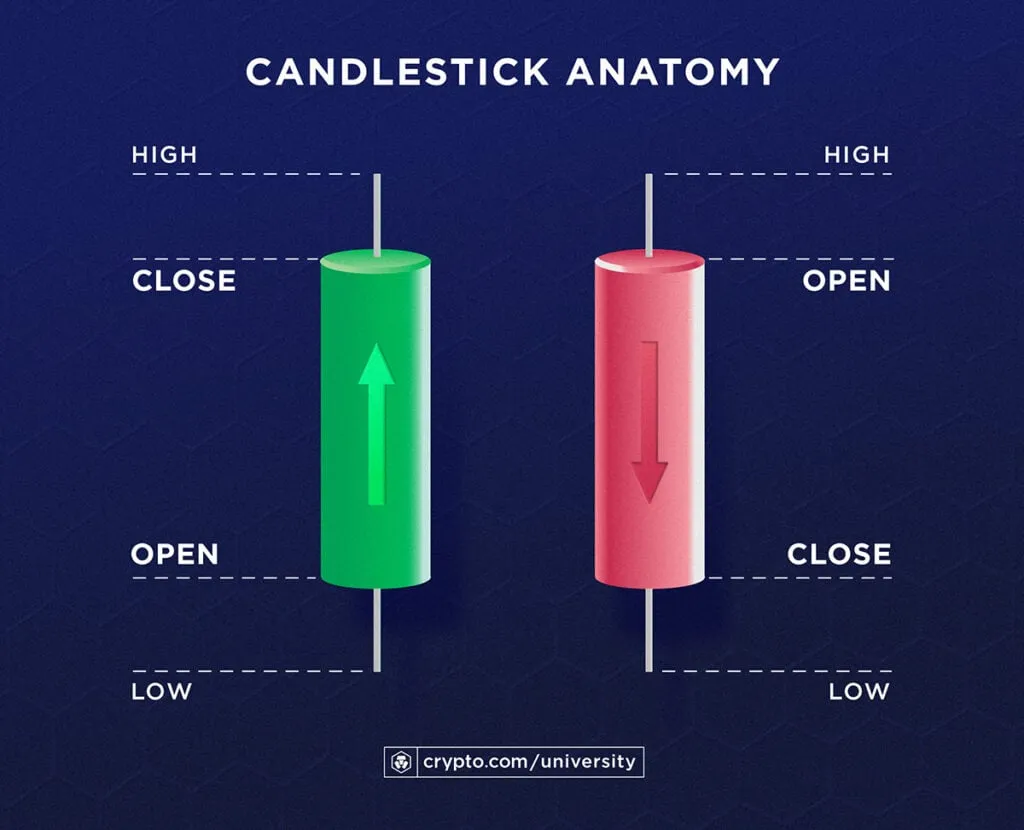

Why candlesticks are widely used in trading charts
Many traders prefer the use of candlestick charts over line charts, as they show a more detailed picture of an asset’s recent and past price movements. With each candlestick showing the opening, closing, high, and low prices, a group of these candlesticks provides more insights into price activity.
There are many nuances within candlesticks that typical line charts don’t show, like how far the closing price is from the high point at the end of a specific period or how much volatility an asset exhibits over certain points of trading.
Candlesticks: introduction to technical analysis
The amount of information a simple candlestick can offer about an asset’s price movement is a fundamental part of technical analysis in crypto trading.
Technical analysis refers to the use of chart patterns, trading volumes, and other market-based information to determine a trader’s next move.
In fact, a lot of well-known technical indicators in trading crypto are based on how combinations of candlesticks appear on a chart.
Related: What to trade without reading crypto charts? Consider Dollar Cost Averaging.
A deeper dive into candlesticks: Terms and descriptions
There are dozens of different candlestick patterns to learn about, but before we go into detail, we need to learn a few more terms and ideas that will help you understand candlesticks better.
Bullish or bearish candlestick patterns
The basic question that most crypto traders consider every day is: “Will the price go up or down?” Therefore, the most interesting candlestick patterns for traders are the ones that show possible upward or downward movements. In other words, traders are always on the lookout for bullish or bearish patterns.
A bullish candlestick pattern shows up after a series of downward price movements and before the succession of price increases. Meanwhile, a bearish candlestick pattern shows up at the peak of a rising price chart and precedes a price fall.
Take note that the bullishness or bearishness of a candlestick pattern is not based on the colour it shows. Each pattern has its own price contexts that can ‘lean’ bullish or bearish in a chart.
Related: Learn the four phases of a crypto market cycle in this article.
Single- or multiple-candlestick patterns
Some individual candlesticks are seen as signals that are strong enough to mark the possibility of a change in price trends. These are called single-candlestick patterns.
However, most candlestick patterns fall under the category of multiple-candlestick patterns. To detect price trends, you’ll need to be familiar with the patterns shown by two or more consecutive candlesticks to detect potential price trends.
Reversal or continuation candlestick patterns
Many candlestick patterns focus on changes of the direction of price, specifically on whether an upward-moving asset might be falling anytime soon, or whether a slumping token will change course and recover. These patterns fall under reversal candlestick patterns.
But not all patterns pinpoint shifts in price movements. Other candlestick patterns can be used to confirm the current trajectory of an asset’s price. These are called continuation candlestick patterns, and detecting these patterns can help traders consider whether or not they should stay the course with their investments.
Now, it’s time to get into some actual indicators.
Marubozus, dojis, and spinning tops
Most individual candlesticks contain a pronounced body and a noticeable wick. But there are other candlesticks that are visually unique, and they often function as strong indicators of potential price trend reversals or continuations.
Marubozu candlestick
An example of such an unusual candlestick is the marubozu, which is Japanese for ‘bald’. This is a kind of candlestick that has a pronounced body and no wick; hence, its moniker. A marubozu shows that the opening and closing prices are identical to the highest and lowest prices over the candlestick’s time period.
Doji candlesticks
Another unique candlestick is the doji. Unlike a marubozu, a doji has a prominent wick and a body so little that the candlestick looks like a cross.
A doji signifies that the opening and closing prices for an asset are equal, no matter how high or low the prices moved within the candlestick’s price period. This irregularity in price movement is where this candlestick gets its name, as ‘doji’ is Japanese for ‘mistake’.
Dojis are further classified into gravestone, which has a lower ‘body’; long-legged, which has its ‘body’ in the middle; and dragonfly, which has a ‘body’ that is closer to the top.


Spinning top candlesticks
Another candlestick type that is quite similar to a doji is a spinning top. Like a doji, this candlestick has a long wick relative to its short body in the middle, resembling a spinning top. Unlike a doji, its body is small but still visible, indicating a slight change in price between opening and closing times, with wide fluctuations in between.
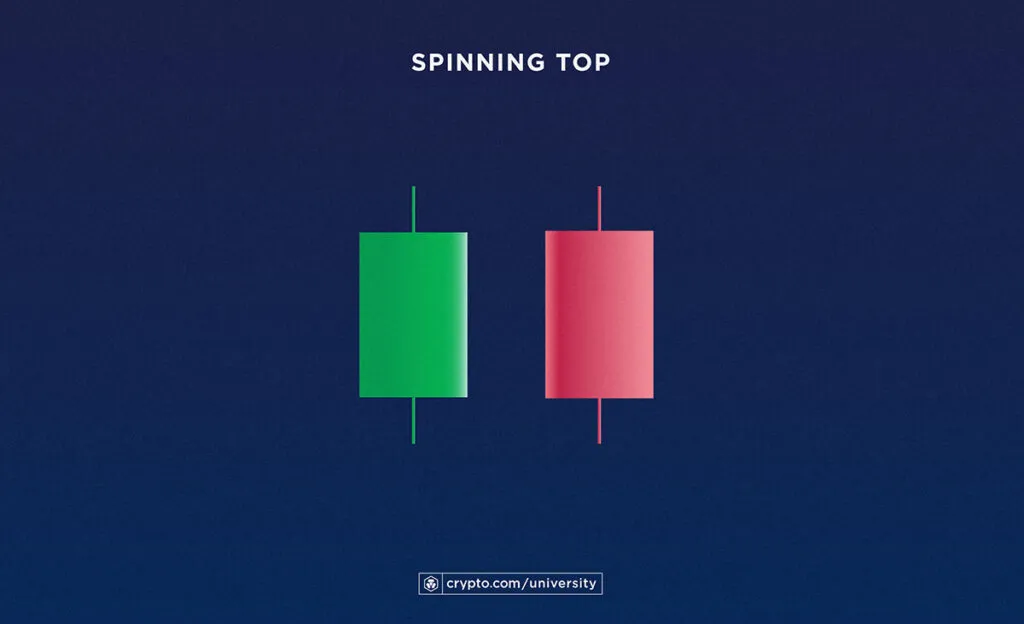

Examples and interpretations of candlestick patterns
Now that we’ve talked about some of the candlestick patterns you will encounter, let’s get into how they may be interpreted as bullish or bearish. Take note that this section is neither an exhaustive list of patterns nor a definitive compilation of pattern interpretations, so treat these examples as a starting point in your learning journey of candlesticks.
Bullish single-candlestick patterns
Let’s recall what a marubozu is — a candlestick that has no wick. Hence, a marubozu that shows a closing price that’s higher than the opening price is widely considered a bullish marubozu.
1) Bullish marubozu
The appearance of this candlestick can be interpreted as indicating that traders want to buy an asset at any given price point during the time period, therefore showing an overall bullish sentiment in the market. This may suggest that an uptrend will potentially follow the bullish marubozu.
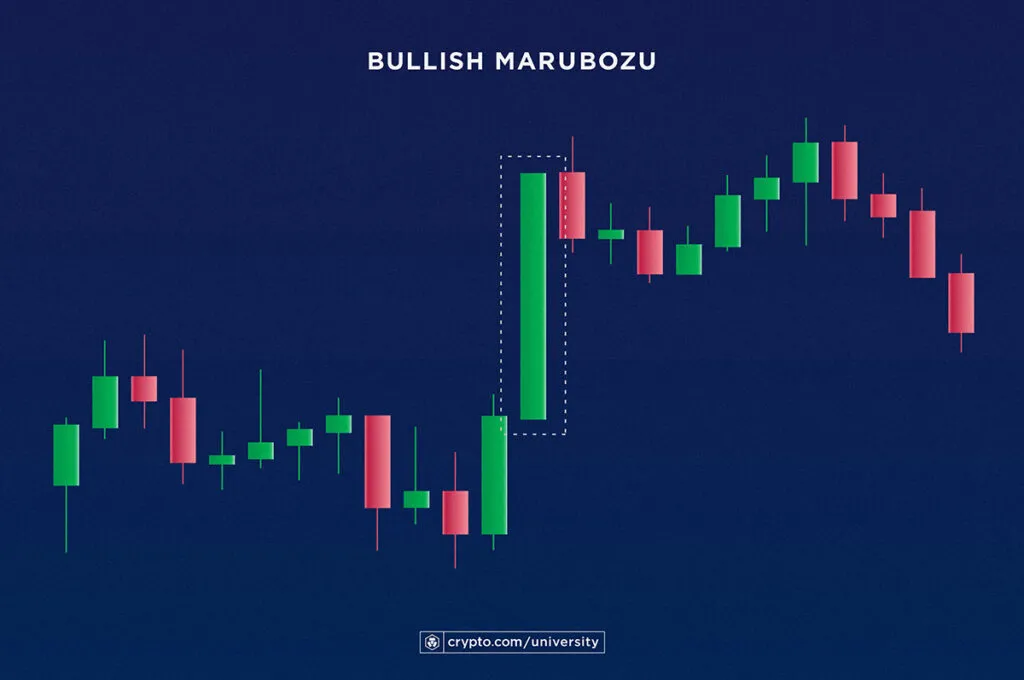

2) Hammer
Another candlestick pattern to look out for is the hammer. This candlestick is characterised by a short body on top, a long wick at the bottom, and little to no wick at the top; hence, its resemblance to the tool.
When the hammer appears after a series of bearish candlesticks, it can potentially signify a bullish price trend ahead. A hammer that appears following a price downtrend can be interpreted as a period of trade where the opening and closing prices are close to each other despite downward price movements, suggesting that the bottom may have been reached and that the market has a chance to reverse moving forward.
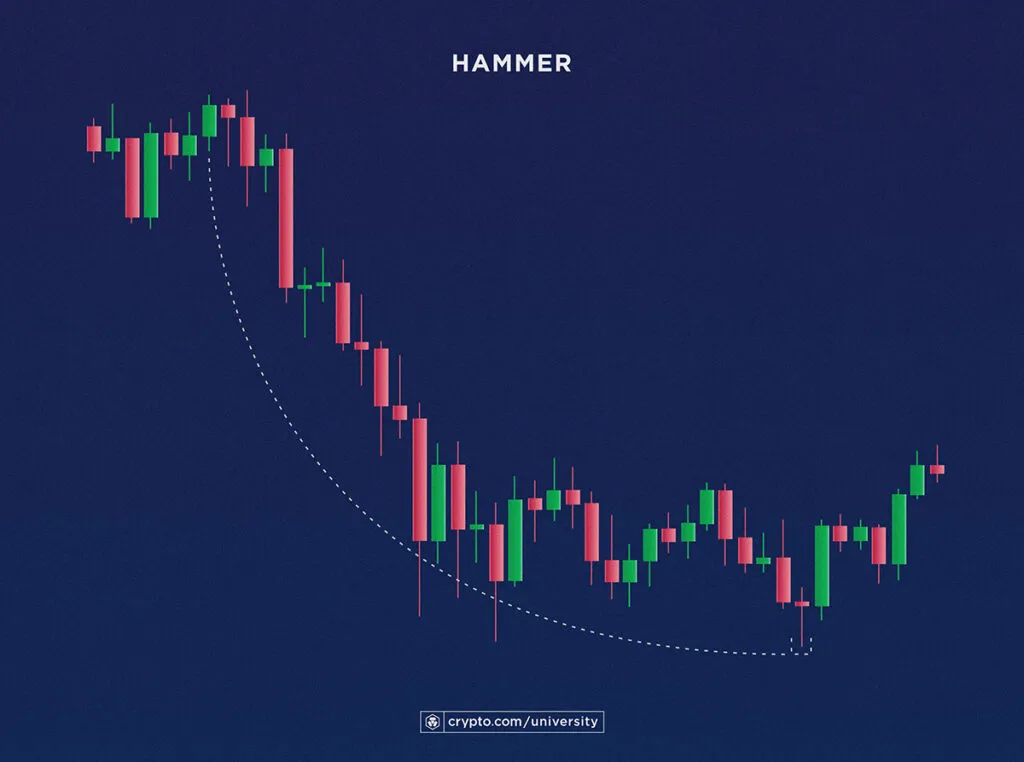

Other examples of single-candlestick patterns that can be considered bullish are the dragonfly doji and bullish spinning top.
Bearish single-candlestick patterns
For our first example of a bearish candlestick pattern, let’s recall the hammer. What if that hammer appears after a series of bullish candlesticks? This candlestick is now called hanging man, and it can suggest that the bullish run of an asset’s price has reached its peak.
1) Hanging man
The hanging man pattern typically shows that the price has changed a little for that time period after a series of increases, and that there was a significant downward fluctuation in the price during that period, indicating that there may be potential price drop ahead.


2) Shooting star
Another bearish candlestick to learn is the shooting star, which is basically a hanging man candlestick turned upside down. A shooting star has a short body at the bottom with little to no wick, plus a long wick at the top, as if it’s a star that leaves a trail while descending. When a shooting star appears after consecutive bullish patterns, it may indicate that the price only changed slightly during the period, despite reaching significantly higher points before the closing rate.
This pattern can be interpreted as a signal that the price may potentially be resistant to further increases, and as a result, slide down moving forward.


Other examples of single-candlestick patterns that can be considered bearish are gravestone doji, bearish spinning top, and bearish marubozu.
Bullish multiple-candlestick patterns
Aside from single-candlestick patterns, there are other candlestick combinations that you can use to project possible price movements.
1) Bullish harami
One example that uses a couple of candlesticks is the bullish harami pattern, characterised by a larger bearish candle that is followed by a smaller bullish candle that is completely within the range of the bearish candle’s body. Harami is Japanese for ‘pregnant’, and the candlestick pair resembles a pregnant being. The pattern shows a heavy price drop, followed by a slight recovery within the bounds of the preceding decrease.
This combination can possibly be interpreted as a bullish signal, which precedes and suggests the potential for more price increases.
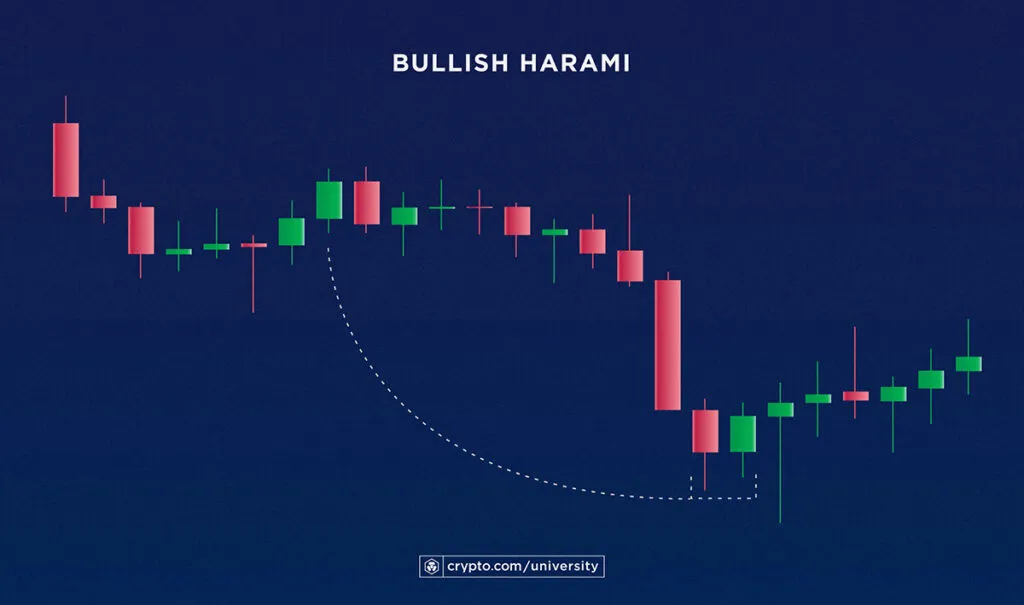

Other multiple-candlestick patterns involve three or more candlesticks.
2) Morning star
For instance, the morning star is a combination of a bearish candle, followed by a doji and then a bullish candle. The presence of the doji between the bullish and bearish candles can be interpreted as showing that between a price decrease and a price increase, there was a period when the price remained the same despite heavy fluctuations during that period. This candlestick combination is interpreted as a trend reversal signal from bearish to bullish.
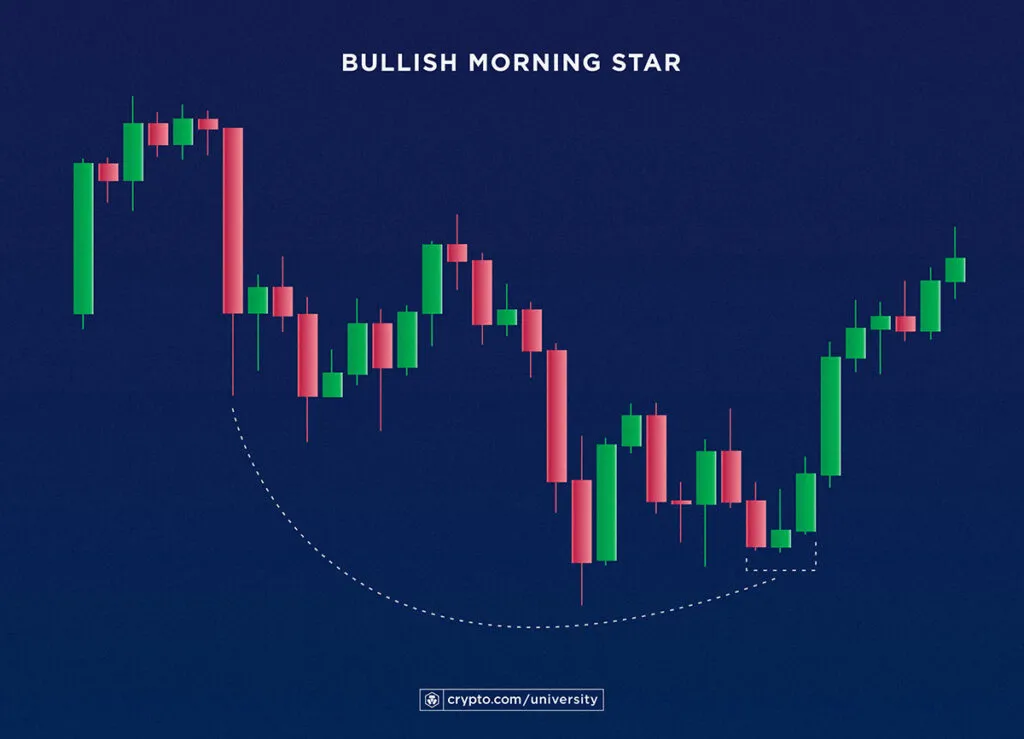

Other examples of multiple-candlestick patterns that can be considered bullish are bullish kicker, bullish engulfing, piercing line, tweezer bottom, bullish abandoned baby, three white soldiers, three inside up, three outside up, and more.
Bearish multiple-candlestick patterns
There are several two-candlestick configurations that can possibly be interpreted as bearish signals. One of these is the bearish engulfing pattern, which basically looks like a bullish harami pattern flipped sideways.
1) Bearish engulfing pattern
Specifically, the pattern starts with a small bullish candle, followed by a larger bearish candle that appears to engulf the preceding candle. This combination, which usually appears following a series of bullish candles, is often interpreted as indicating that a weak price increase has been followed by a bigger price decrease, therefore suggesting a potential downtrend.
Meanwhile, an example of a bearish multiple-candlestick pattern that involves three candlesticks is the three black crows.
2) Three black crows
This pattern shows a series of three bearish candles with wide enough bodies and short wicks, with some overlap on each other’s starting and closing price ranges. When the three black crows pattern appears after a bullish price trend, it is often suggested that there may be a potential downtrend, as successive bearish candles seem to have debunked further growth prospects for the asset being studied.
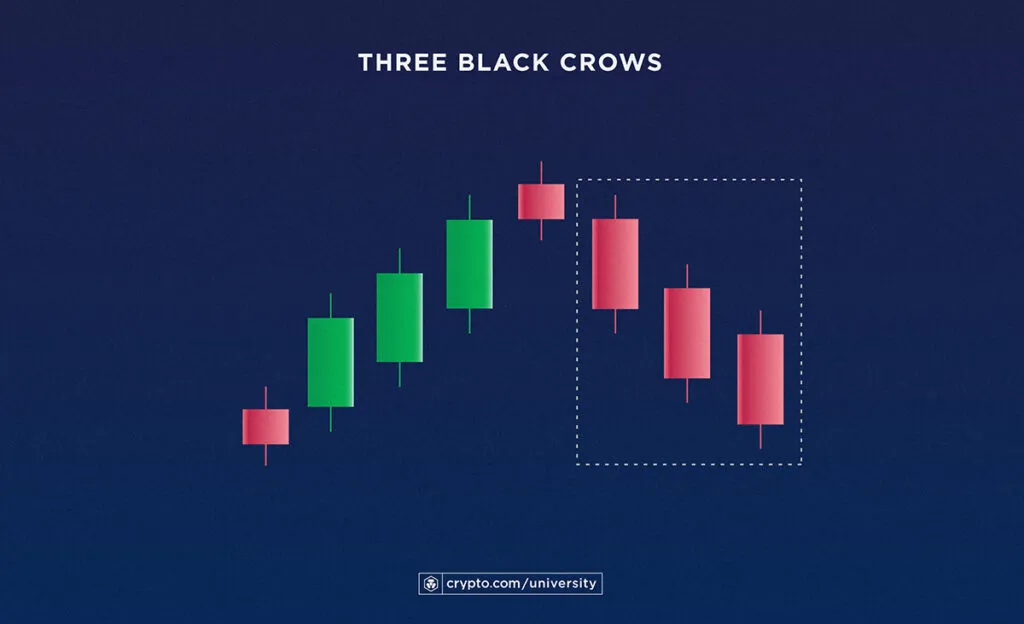

Other examples of multiple-candlestick patterns that can be considered bearish are bearish kicker, bearish harami, evening star, dark cloud cover, tweezer top, bearish abandoned baby, three inside down, three outside down, and more.
When to rely on candlesticks and when to stop
The use of candlesticks can be a good starting point in your crypto trading journey, as they can help you assess the potential of price changes. Each candlestick pattern tells a short-term story of market sentiment and decisions made. As candlesticks are the easiest indicators to look for, they can unlock more insights into price action, especially when combined with other technical analysis indicators.
With that said, candlesticks should never serve as the definitive indicator for your trades, no matter how experienced you are in crypto trading, particularly if you start trading bigger volumes.
Candlestick patterns do not serve as absolute projections of future price movements, and there are countless times when the market went against the expected direction indicated by the patterns.
As commonly echoed, past performance is not an indicator of future results. With this in mind, it is best to learn more trading techniques and combine these techniques with the interpretation of candlesticks so you can make the most of your experience on Crypto.com.
Important information:mThis is informational content sponsored by Crypto.com and should not be considered as investment advice. Trading cryptocurrencies carries risks, such as price volatility and market risks. Before deciding to trade cryptocurrencies, consider your risk appetite. Services, features and other benefits referenced in this article may be subject to eligibility requirements, token holdings, and may change at the discretion of Crypto.com.
Past performance may not indicate future results. There's no assurance of future profitability, and content may not reflect current opinions.
Share with Friends
Ready to start your crypto journey?
Get your step-by-step guide to setting upan account with Crypto.com
By clicking the Submit button you acknowledge having read the Privacy Notice of Crypto.com where we explain how we use and protect your personal data.
